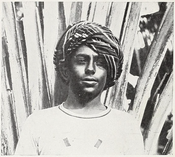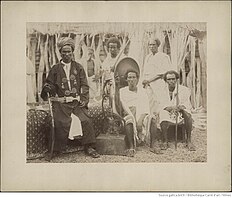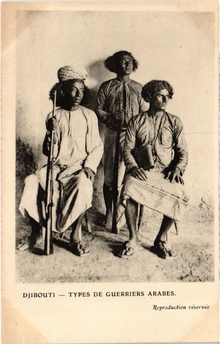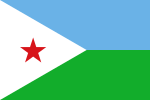Djiboutians
Cushitic people ) populations |
The Djiboutians (
Demographics

Djibouti has a population of about 884,017 inhabitants.
| Ethnic composition of Djibouti 1927 - 2016 | |||||||||||
|---|---|---|---|---|---|---|---|---|---|---|---|
| 1927 | Population | 1983 | Population | 2016 | Population | ||||||
Somali |
32,287 | Somali |
250,500 | Somali |
524,000 | ||||||
| Afar | 48,520 | Afar | 175,100 | Afar | 306,000 | ||||||
Arabs |
4,135 | Arabs |
30,000 | Arabs |
59,000 | ||||||
| 84,942 | 455,600 | 846,687 | |||||||||
After the civil war in 1991, many Djiboutians emigrated abroad. Most reside in Europe, North America and the Middle East.

Culture
Djiboutians' culture is primarily rooted in Somali and Afar traditions. They speak different

Cuisine
 |
| Part of a series on the |
| Culture of Djibouti |
|---|
| Culture |
|
People |
|
Religion |
| Language |
| Politics |
|
|
Music
Djiboutian music has Somali and Afar roots. Most Somali songs follow the pentatonic scale. That is, they only use five pitches per octave in contrast to a heptatonic (seven note) scale, often found in Western music. At first listen, Somali music might be mistaken for the sounds of nearby regions such as Ethiopia, Sudan or the Arabian Peninsula, but it is ultimately recognizable by its own unique tunes and styles. Traditional Afar music resembles the folk music of other parts of the Horn of Africa such as Ethiopia; it also contains elements of Arabic music. The history of Djibouti is recorded in the poetry and songs of its nomadic people, and goes back thousands of years to a time when the peoples of Djibouti traded hides and skins for the perfumes and spices of ancient Egypt, India, and China. Afar Oral Literature is also quite musical. Popular Djiboutian musicians include Nima Djama, Abdo Xamar Qoodh, Mohamed Ali Fourchette, Abdallah Lee, Said Xamar Qoodh, and Xabiiba Cabdilaahi.
Cinema
Storytelling is an ancient custom in Djiboutian culture. This tradition is continued by a love of cinema. The earliest forms of public film display in Djibouti were in
During the 1970s, the capital city had five movie theaters, with one in each district. A few local attempts at film making were also concurrently carried out with the participation of local actors. One of these was Burta Djinka, a film in Somali directed by G. Borg in 1972. Following independence in 1977, a growing number of government-owned production and distribution companies as well as actual projection theaters sprang up.
In the 1990s two of the biggest cinemas, Odeon and Olympia, closed their doors.[7]
Languages
The languages of Djibouti include
Religion
Islam entered the region very early on, as a group of persecuted Muslims had sought refuge across the Red Sea in the Horn of Africa at the urging of the Islamic prophet Muhammad. In 1900, during the early part of the colonial era, there were virtually no Christians in the area, with only about 100–300 followers coming from the schools and orphanages of the few Catholic missions in French Somaliland. Islam is the driving force behind the unity of varying ethnic groups from different parts of the country, and has significantly shaped the values and traditions of Djibouti.
Notable Djiboutians
- Hassan Gouled Aptidon, first President of Djibouti from 1977 to 1999
- Mahmoud Harbi, vice-president of the Government Council of French Somaliland
- Ahmed Dini Ahmed, Prime Minister of Djibouti from 1977 to 1978
- Dileita Mohamed Dileita, Prime Minister of Djibouti from 2001 to 2013
- Hussein Ahmed Salah, Marathon runner
- Jamal Abdi Dirieh, Athlete
- Ayanleh Souleiman, Professional athlete
- Mouna-Hodan Ahmed, Novelist
- Lula Ali Ismaïl, Djiboutian-Canadian film director
- Roda Ali Wais, Athlete
- Zeinab Kamel Ali, Politician
- Abdourahman Waberi, Novelist
- Abdo Xamar Qoodh, Musician
- Ismail Hassan, Footballer
- Abdi Waiss Mouhyadin, Athlete
- Daher Ahmed Farah, Politician
- Youssouf Hiss Bachir, Athlete
- Ahmed Goumane-Roble, Politician
- Abdourahman Waberi, Novelist
- Nima Djama, Musician
- Hasna Mohamed Dato, Politician
- Mumin Gala, Athlete
- Omar Farah Iltireh, Politician
- Yacin Elmi Bouh, Politician
- Aden Robleh Awaleh, President of the National Democratic Party
- Mohamed Ali Fourchette, Musician
- Shanice Dileita Mohamed, Musician
- Moumin Bahdon Farah, Politician
Notes
- ^ a b "Djibouti". The World Factbook. CIA.
- ^ "World Population Prospects 2022". United Nations Department of Economic and Social Affairs, Population Division. Retrieved July 17, 2022.
- ^ "World Population Prospects 2022: Demographic indicators by region, subregion and country, annually for 1950-2100" (XSLX) ("Total Population, as of 1 July (thousands)"). United Nations Department of Economic and Social Affairs, Population Division. Retrieved July 17, 2022.
- ^ Refugees, United Nations High Commissioner for. "Refworld | Somalia: Information on the Issa and the Issaq". Refworld. Retrieved 2021-10-10.
- ^ Barlin Ali, Somali Cuisine, (AuthorHouse: 2007), p.79
- ^ M. Guedi Ali Omar. "Observatoire Culturel ACP: RAPPORT FINAL REPUBLIQUE DE DJIBOUTI" (PDF). Archived from the original (PDF) on 2016-08-22. Retrieved 2016-07-13.
- ^ M. Guedi Ali Omar. "Observatoire Culturel ACP: RAPPORT FINAL REPUBLIQUE DE DJIBOUTI" (PDF). Archived from the original (PDF) on 2016-08-22. Retrieved 2016-07-13.

